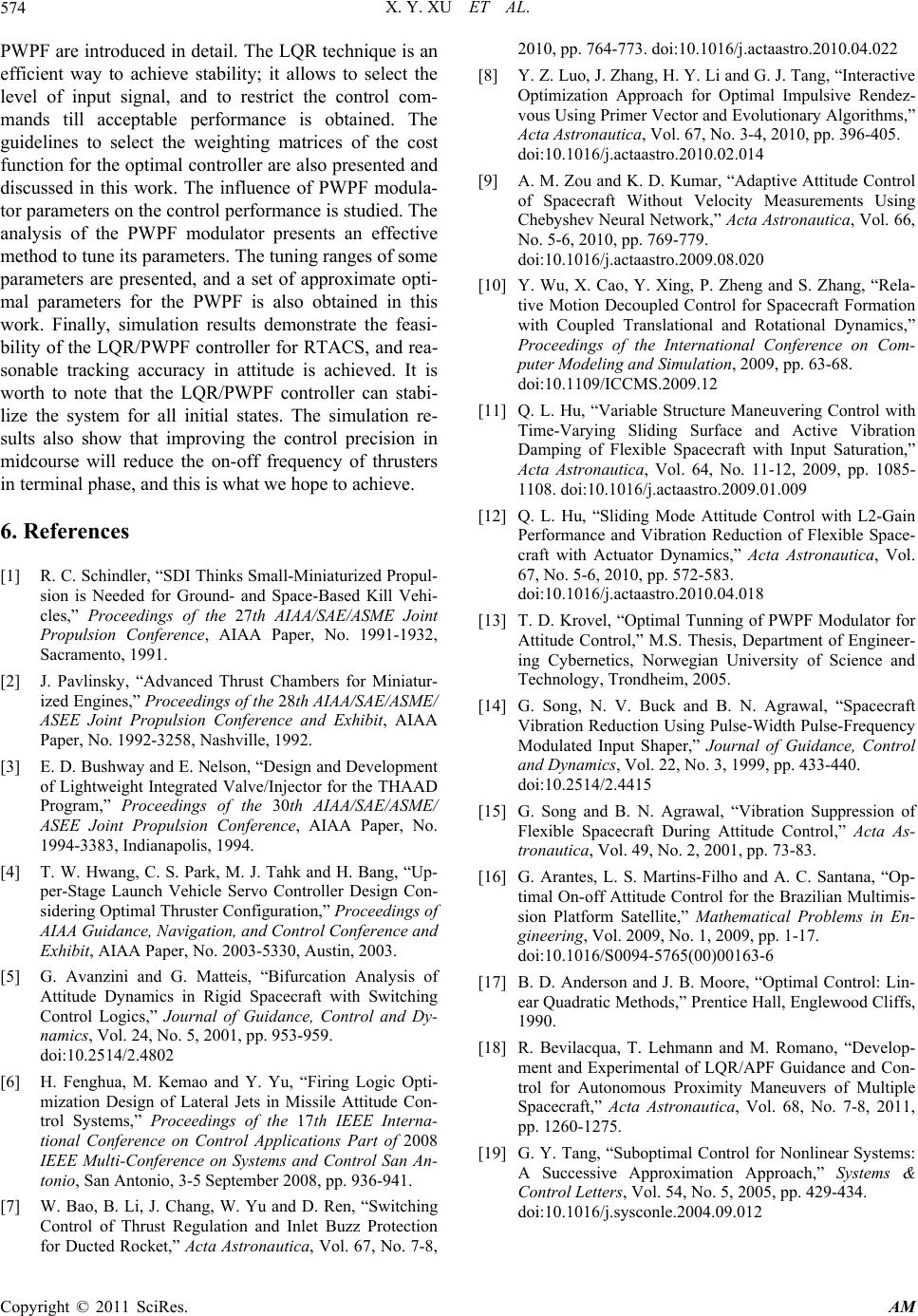
X. Y. XU ET AL.
574
PWPF are introduced in detail. The LQR technique is an
efficient way to achieve stability; it allows to select the
level of input signal, and to restrict the control com-
mands till acceptable performance is obtained. The
guidelines to select the weighting matrices of the cost
function for the optimal controller are also presented and
discussed in this work. The influence of PWPF modula-
tor parameters on the control performance is studied. The
analysis of the PWPF modulator presents an effective
method to tune its parameters. The tuning ranges of some
parameters are presented, and a set of approximate opti-
mal parameters for the PWPF is also obtained in this
work. Finally, simulation results demonstrate the feasi-
bility of the LQR/PWPF controller for RTACS, and rea-
sonable tracking accuracy in attitude is achieved. It is
worth to note that the LQR/PWPF controller can stabi-
lize the system for all initial states. The simulation re-
sults also show that improving the control precision in
midcourse will reduce the on-off frequency of thrusters
in terminal phase, and this is what we hope to achieve.
6. References
[1] R. C. Schindler, “SDI Thinks Small-Miniaturized Propul-
sion is Needed for Ground- and Space-Based Kill Vehi-
cles,” Proceedings of the 27th AIAA/SAE/ASME Joint
Propulsion Conference, AIAA Paper, No. 1991-1932,
Sacramento, 1991.
[2] J. Pavlinsky, “Advanced Thrust Chambers for Miniatur-
ized Engines,” Proceedings of the 28th AIAA/SAE/ASME/
ASEE Joint Propulsion Conference and Exhibit, AIAA
Paper, No. 1992-3258, Nashville, 1992.
[3] E. D. Bushway and E. Nelson, “Design and Development
of Lightweight Integrated Valve/Injector for the THAAD
Program,” Proceedings of the 30th AIAA/SAE/ASME/
ASEE Joint Propulsion Conference, AIAA Paper, No.
1994-3383, Indianapolis, 1994.
[4] T. W. Hwang, C. S. Park, M. J. Tahk and H. Bang, “Up-
per-Stage Launch Vehicle Servo Controller Design Con-
sidering Optimal Thruster Configuration,” Proceedings of
AIAA Guidance, Navigation, and Control Conference and
Exhibit, AIAA Paper, No. 2003-5330, Austin, 2003.
[5] G. Avanzini and G. Matteis, “Bifurcation Analysis of
Attitude Dynamics in Rigid Spacecraft with Switching
Control Logics,” Journal of Guidance, Control and Dy-
namics, Vol. 24, No. 5, 2001, pp. 953-959.
doi:10.2514/2.4802
[6] H. Fenghua, M. Kemao and Y. Yu, “Firing Logic Opti-
mization Design of Lateral Jets in Missile Attitude Con-
trol Systems,” Proceedings of the 17th IEEE Interna-
tional Conference on Control Applications Part of 2008
IEEE Multi-Conference on Systems and Control San An-
tonio, San Antonio, 3-5 September 2008, pp. 936-941.
[7] W. Bao, B. Li, J. Chang, W. Yu and D. Ren, “Switching
Control of Thrust Regulation and Inlet Buzz Protection
for Ducted Rocket,” Acta Astronautica, Vol. 67, No. 7-8,
2010, pp. 764-773. doi:10.1016/j.actaastro.2010.04.022
[8] Y. Z. Luo, J. Zhang, H. Y. Li and G. J. Tang, “Interactive
Optimization Approach for Optimal Impulsive Rendez-
vous Using Primer Vector and Evolutionary Algorithms,”
Acta Astronautica, Vol. 67, No. 3-4, 2010, pp. 396-405.
doi:10.1016/j.actaastro.2010.02.014
[9] A. M. Zou and K. D. Kumar, “Adaptive Attitude Control
of Spacecraft Without Velocity Measurements Using
Chebyshev Neural Network,” Acta Astronautica, Vol. 66,
No. 5-6, 2010, pp. 769-779.
doi:10.1016/j.actaastro.2009.08.020
[10] Y. Wu, X. Cao, Y. Xing, P. Zheng and S. Zhang, “Rela-
tive Motion Decoupled Control for Spacecraft Formation
with Coupled Translational and Rotational Dynamics,”
Proceedings of the International Conference on Com-
puter Modeling and Simulation, 2009, pp. 63-68.
doi:10.1109/ICCMS.2009.12
[11] Q. L. Hu, “Variable Structure Maneuvering Control with
Time-Varying Sliding Surface and Active Vibration
Damping of Flexible Spacecraft with Input Saturation,”
Acta Astronautica, Vol. 64, No. 11-12, 2009, pp. 1085-
1108. doi:10.1016/j.actaastro.2009.01.009
[12] Q. L. Hu, “Sliding Mode Attitude Control with L2-Gain
Performance and Vibration Reduction of Flexible Space-
craft with Actuator Dynamics,” Acta Astronautica, Vol.
67, No. 5-6, 2010, pp. 572-583.
doi:10.1016/j.actaastro.2010.04.018
[13] T. D. Krovel, “Optimal Tunning of PWPF Modulator for
Attitude Control,” M.S. Thesis, Department of Engineer-
ing Cybernetics, Norwegian University of Science and
Technology, Trondheim, 2005.
[14] G. Song, N. V. Buck and B. N. Agrawal, “Spacecraft
Vibration Reduction Using Pulse-Width Pulse-Frequency
Modulated Input Shaper,” Journal of Guidance, Control
and Dynamics, Vol. 22, No. 3, 1999, pp. 433-440.
doi:10.2514/2.4415
[15] G. Song and B. N. Agrawal, “Vibration Suppression of
Flexible Spacecraft During Attitude Control,” Acta As-
tronautica, Vol. 49, No. 2, 2001, pp. 73-83.
[16] G. Arantes, L. S. Martins-Filho and A. C. Santana, “Op-
timal On-off Attitude Control for the Brazilian Multimis-
sion Platform Satellite,” Mathematical Problems in En-
gineering, Vol. 2009, No. 1, 2009, pp. 1-17.
doi:10.1016/S0094-5765(00)00163-6
[17] B. D. Anderson and J. B. Moore, “Optimal Control: Lin-
ear Quadratic Methods,” Prentice Hall, Englewood Cliffs,
1990.
[18] R. Bevilacqua, T. Lehmann and M. Romano, “Develop-
ment and Experimental of LQR/APF Guidance and Con-
trol for Autonomous Proximity Maneuvers of Multiple
Spacecraft,” Acta Astronautica, Vol. 68, No. 7-8, 2011,
pp. 1260-1275.
[19] G. Y. Tang, “Suboptimal Control for Nonlinear Systems:
A Successive Approximation Approach,” Systems &
Control Letters, Vol. 54, No. 5, 2005, pp. 429-434.
doi:10.1016/j.sysconle.2004.09.012
Copyright © 2011 SciRes. AM